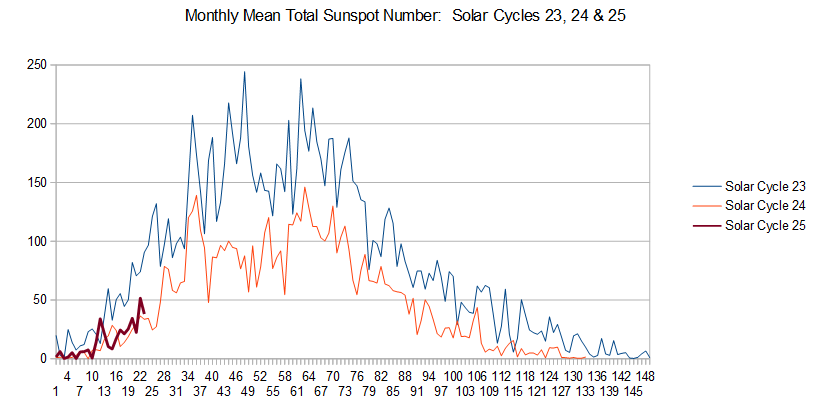|
|
Post by glennkoks on Oct 4, 2021 15:17:26 GMT
|
|
|
|
Post by blustnmtn on Oct 4, 2021 16:16:37 GMT
|
|
|
|
Post by blustnmtn on Oct 11, 2021 17:17:31 GMT
Incoming!  A moderate (G2) geomagnetic storm watch will be in effect beginning Monday, October 11th when a coronal mass ejection (CME) observed on Saturday is expected to sweep past Earth. Aurora sky watchers should be alert within the next 48-72 hours. The CME was the result of an M1.6 solar flare around AR 2882, now directly facing Earth. |
|
|
|
Post by code on Oct 17, 2021 3:17:10 GMT
Someone over at Harvard thinks it will be short lived.
|
|
|
|
Post by blustnmtn on Oct 31, 2021 2:32:44 GMT
|
|
|
|
Post by Sigurdur on Oct 31, 2021 2:51:20 GMT
|
|
|
|
Post by missouriboy on Nov 1, 2021 16:34:58 GMT
Mean Daily Sunspots for October, 2021 dropped from the September value. Still on track with SC24. Big jumps during SC24 occurred in months 31 and 37. We are now at month 26 of SC25.  And a comparison to Solar Cycles 5 and 6 of the Dalton Minimum.  |
|
|
|
Post by missouriboy on Dec 1, 2021 18:00:29 GMT
Mean daily Monthly sunspot number declined from 38 in October to 35 for November. Still right on the SC24 track.
|
|
|
|
Post by farmerpipes on Dec 9, 2021 2:49:26 GMT
There is some suspicion that the 'official' sunspot count is being fudged down. Not sure if this is extending to the F10.7 flux numbers also, but in this post-truth world, nothing would surprise me. We have had more rain here and summer is yet to appear, Bz has remained negative, the Moon, Jupiter, Saturn and Venus have been in close proximity for a while also. In my muddled hypothesis, these things should result in an increasing susnpot count/increase in solar activity - certainly greater than the bizarrely low 13 today.
|
|
|
|
Post by acidohm on Dec 9, 2021 21:35:43 GMT
There is some suspicion that the 'official' sunspot count is being fudged down. Not sure if this is extending to the F10.7 flux numbers also, but in this post-truth world, nothing would surprise me. We have had more rain here and summer is yet to appear, Bz has remained negative, the Moon, Jupiter, Saturn and Venus have been in close proximity for a while also. In my muddled hypothesis, these things should result in an increasing susnpot count/increase in solar activity - certainly greater than the bizarrely low 13 today. Not sure how something that is measurable by many sources can be altered to fit a narrative. |
|
|
|
Post by ratty on Dec 10, 2021 0:09:18 GMT
There is some suspicion that the 'official' sunspot count is being fudged down. Not sure if this is extending to the F10.7 flux numbers also, but in this post-truth world, nothing would surprise me. We have had more rain here and summer is yet to appear, Bz has remained negative, the Moon, Jupiter, Saturn and Venus have been in close proximity for a while also. In my muddled hypothesis, these things should result in an increasing susnpot count/increase in solar activity - certainly greater than the bizarrely low 13 today. Not sure how something that is measurable by many sources can be altered to fit a narrative. Think Climategate? |
|
|
|
Post by missouriboy on Dec 10, 2021 0:15:40 GMT
Someone over at Harvard thinks it will be short lived.
They were a year off the start point for SC25. |
|
|
|
Post by farmerpipes on Dec 14, 2021 10:31:31 GMT
Are there other sunspot counts published besides those shown on solen.info? I understand these come from/are collated by the USAF now after a change recently? F20.7 has traditionally been measured by Canada.
|
|
|
|
Post by blustnmtn on Dec 14, 2021 13:21:34 GMT
Are there other sunspot counts published besides those shown on solen.info? I understand these come from/are collated by the USAF now after a change recently? F20.7 has traditionally been measured by Canada. You may find the info here interesting: spaceweather.com/glossary/sunspotnumber.html |
|
|
|
Post by missouriboy on Dec 15, 2021 18:16:47 GMT
SUNSPOT GENESIS: The sunspot number is rapidly increasing as a profusion of dark cores emerges in the sun's southern hemisphere. This 24-hour movie from NASA's Solar Dynamics Observatory shows sunspot genesis in action: spaceweather.com/ |
|